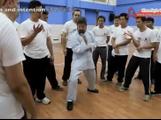
Toronto Sept. 2010 workshop group photo
Here are my notes:
- Anchor the hands, pull from the front foot, mid section, shoulder, and elbow. On the way out, hand leads the elbow, shoulder, front kua, rear kua, rear knee, and rear foot. Extend the hand fully to the maximum, and then somehow the energy will reverse itself.
- Everything comes from the foot.
- Find the fixed spot on the opponent or point in space, then rotate around it.
- Peg the rope 9 times, each section needs to be tight (with tension).
- 2 S makes a figure 8, we perform 1 S, the other S is just the energy.
- Cross hands: hands out and hit the limits (like walls), bring the shoulder to the kua by sinking the shoulders, the kua rotates down (another side of the kua actually rotates up at the same time).
- Concept – Steal the beam, change the pillar: If you have 8 legs under a table top, you can remove two legs from one side, plant them at a different location, move the table top over to go on top of the two legs at the new location. When we move the table top, we are again pegging. Note that there is no concept of shifting in Practical Method.
- Start the action with a split: push foot horizontally and hand goes diagonally, so we have 2 vectors.
- Force always goes straight. Body action can turn. Our job is to separate body and force.
- Hollow the side, while maintaining the outside (structure).
- Exercise: Touch blocking coat – elbow goes back, knee goes forward; hand continues to point forward, the waist turns backward, at the very end, hammer it. Knees need to be complete straight, so that if someone kicks on your knee, your kua turns, and you fall to the floor, but nothing breaks.
- How to move after the leg is fully extended?
- The energy goes to the heel of the extended leg, so you are already there.
- Land your toe without your entire body come up.
- Taoist theory: It’s not the same, but it’s not different. Experiment done at time A is not the same as the same experiment done at point B. Unfortunately, I already forget how this theory is relevant to Taiji.
- Exercise: Touch. Don’t let component detect any change, move in without pushing.
- Exercise: Same move several time, the last time more rotation.
- Process of learning taiji: Physical Stage – Strong (low grade), stiff, stiff but no muscle, solid, smooth, full, effortless (high grade).
- Before you reach the real taiji state, there is always a technique to defeat each state in the physical stage.
- Find fullness after contact, and then a slight intent can cause the other person to move.
- Stop the flow of energy, and then the energy is gone.
- If you are full, there is nowhere the opponent can stop the energy.
- A ball is full.
- Exercise: Elbow in,bring dantian to the rear foot or rear foot to dantian.
- Stretch, don’t move.
- Exercise: 3 rubber cord exercises
- Concept: Adhere, stick, link, follow
- 3 halves of the circles


